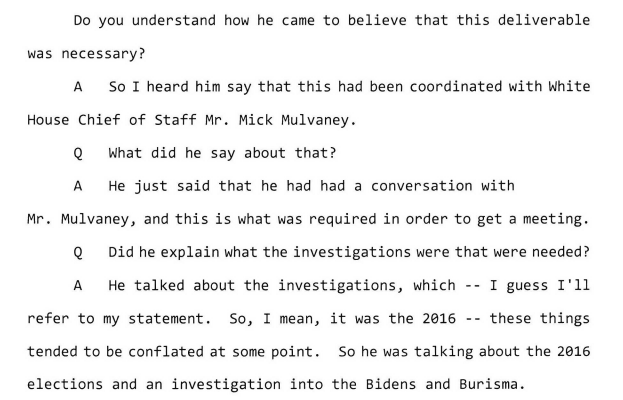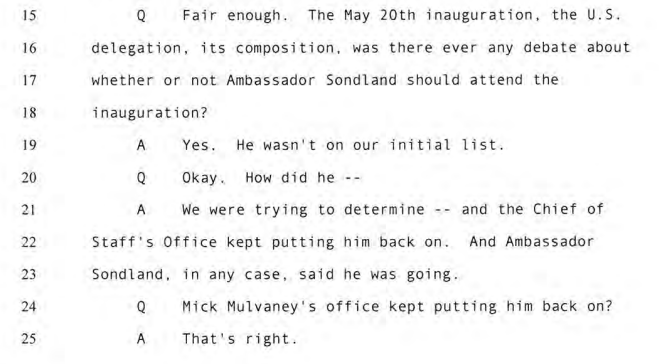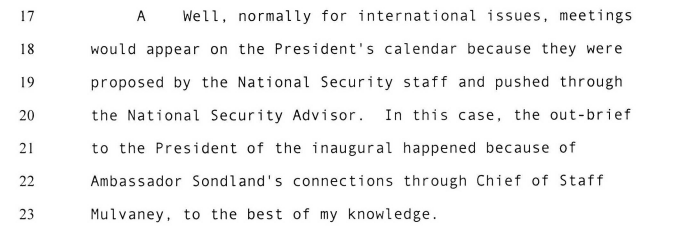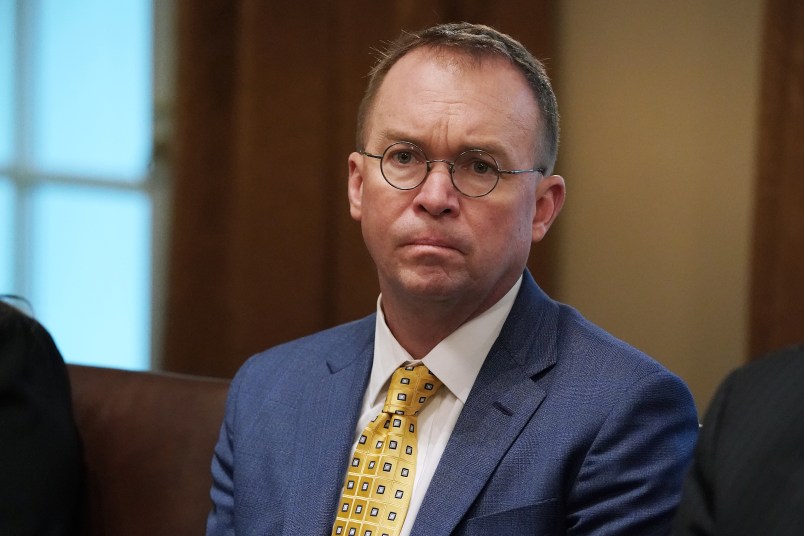White House aides who raised concerns about President Trump’s Ukraine pressure campaign told House investigators that Mick Mulvaney was more deeply involved than previously known, according to deposition transcripts released this week.
“Nobody knew” what two U.S. diplomats running point on the campaign were doing in mid-July, “beyond chief of staff Mulvaney,” former White House aide Fiona Hill testified.
“It was not going down with the rest of the staff,” she said.
She and others described several indications that Mulvaney had a direct role in the effort, from how often he met with the key players to his involvement in an invitation to Ukraine for a White House visit that was later used as leverage.
Mulvaney himself was subpoenaed for testimony, but blew off the deposition on Friday. As House Democrats move towards the public phase of the impeachment inquiry, they’ve signaled that they believe they already have enough to make their case to the American people — with or without any more cooperating witnesses. The investigation is focused on the efforts by Trump and his allies to secure public announcements from Ukraine of investigations into Joe Biden’s family and conspiracy theories about the 2016 hack of Democratic emails.
From those who have testified, a picture emerges of a White House chief of staff who both sanctioned the investigation request to Ukraine and who more broadly helped to facilitate the implementation of the scheme.
Both Hill and another NSC aide, Lt. Col. Alexander Vindman, said that they were told that Mulvaney had coordinated a request for investigations that was expressed to Ukrainian officials during a July 10 visit at the White House.
They each described hearing that from Gordon Sondland, the U.S ambassador to the E.U. who was coaching the Ukrainian diplomats on how to acquiesce to President Trump and Rudy Giuliani’s demands. Hill testified that, while they were meeting with the Ukrainians, Sondland brought an “agreement” with Mulvaney for a Zelensky White House meeting if Ukraine was “to go forward with the investigations.”
Vindman recalled Sondland bringing up Mulvaney when Vindman confronted him, after that meeting, about the inappropriateness of the request.

Then-National Security Advisor John Bolton also had connected Mulvaney to Sondland’s efforts, according to Hill’s testimony.
But signs of Mulvaney’s involvement predated the July visit by the Ukrainians. Both Hill and another witness, State Department official George Kent, testified that Mulvaney likely added Sondland to the delegation that the Trump administration sent to the May inauguration of Ukrainian President Volodymyr Zelensky.
Mulvaney’s office “kept putting him back on” the delegation list, Hill said.

Kent also believed that Mulvaney was the reason Trump met in the Oval Office with the U.S. delegation when they returned from Ukraine. That May 23 meeting is where Trump told the participants, which also included U.S. envoy to Ukraine Kurt Volker, to “talk to Rudy”, after expressing anger about the “problem” of Ukraine.

After the Oval Office meeting, Sondland told Hill that he dictated to Trump and Mulvaney the letter that Trump sent inviting Zelensky to the White House. Getting a date scheduled for that meeting was later used to pressure Ukraine into announcing Biden and 2016 probes.
“So Ambassador Sondland coordinated on that letter directly with the Chief of Staff, and it did not go back through the National Security Council Exec Sec. I had to get that letter directly from the White House Exec Sec.,” Hill recalled.
The most striking sign of Mulvaney’s involvement was his order that military assistance be frozen. Both Vindman and Hill recalled finding out in July that the freeze had come directly from his office.
Hill confirmed that Mulvaney’s communications about the freeze were unusual, because no explanation for the halt was being given.
She said that she had hoped that others would talk to him about why it was on hold, but that she left the White House before she got an answer. Mulvaney himself admitted in a press conference that the aid was frozen for the 2016 probe.
The accounts of Mulvaney’s involvement are particularly striking after Sondland — whose already had to amend his testimony after his recollection was “refreshed” by the claims of other witnesses — downplayed Mulvaney’s role.
Sondland said Mulvaney was “impossible” to get a hold of.
Hill, meanwhile, said Sondland was “certainly” meeting Mulvaney on a “regular basis.”
Bolton’s office looked right into the entrance of Mulvaney’s, Hill noted, and it didn’t require her to have secret conversations with high ranking officials to know that Sondland was in there.
“People who are sitting on the staff of Ambassador BoIton could see Gordon Sondland going into Mulvaney’s offifce,” Hill said. “The guards could see Ambassador Sondland going into Mulvaney’s office.”










